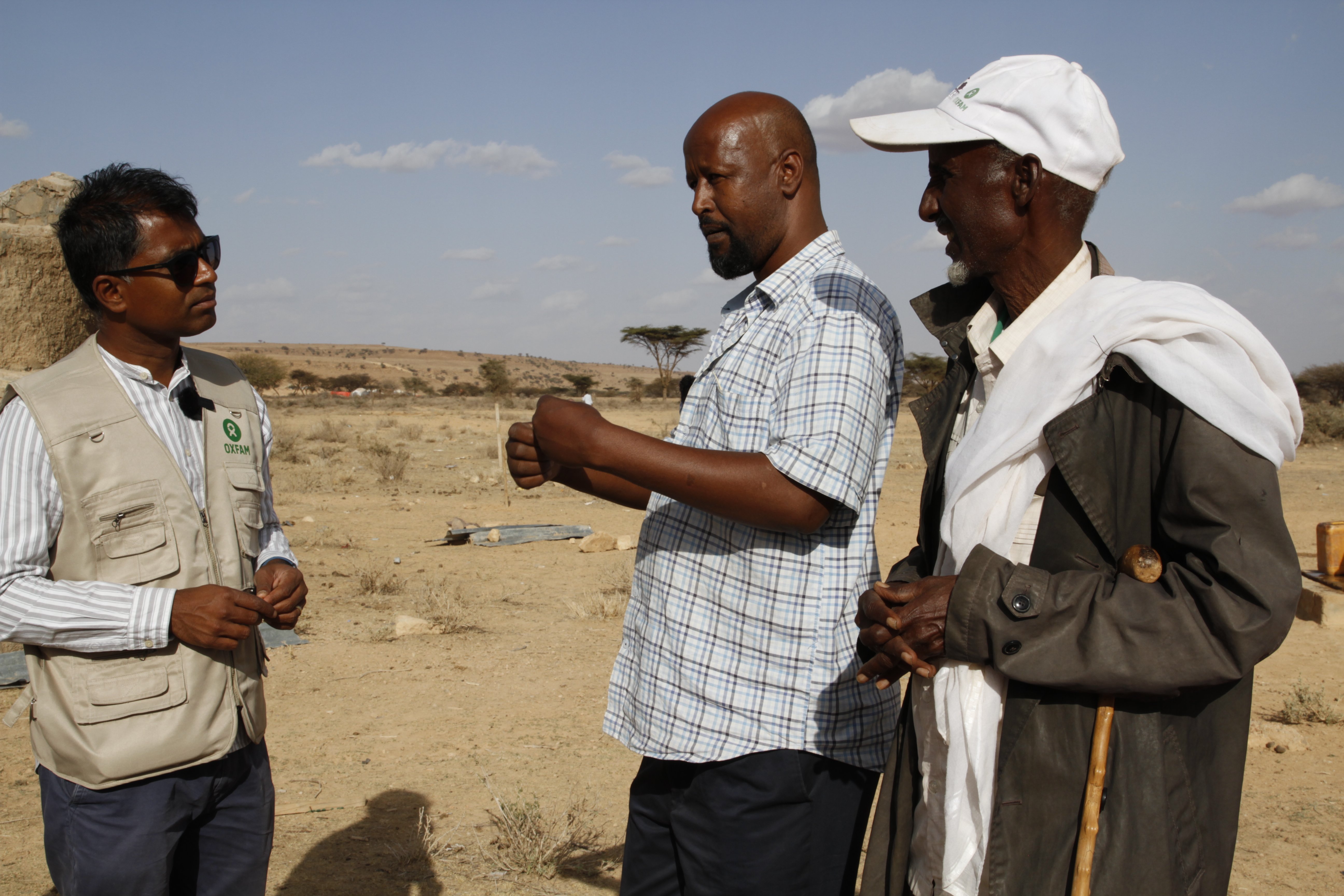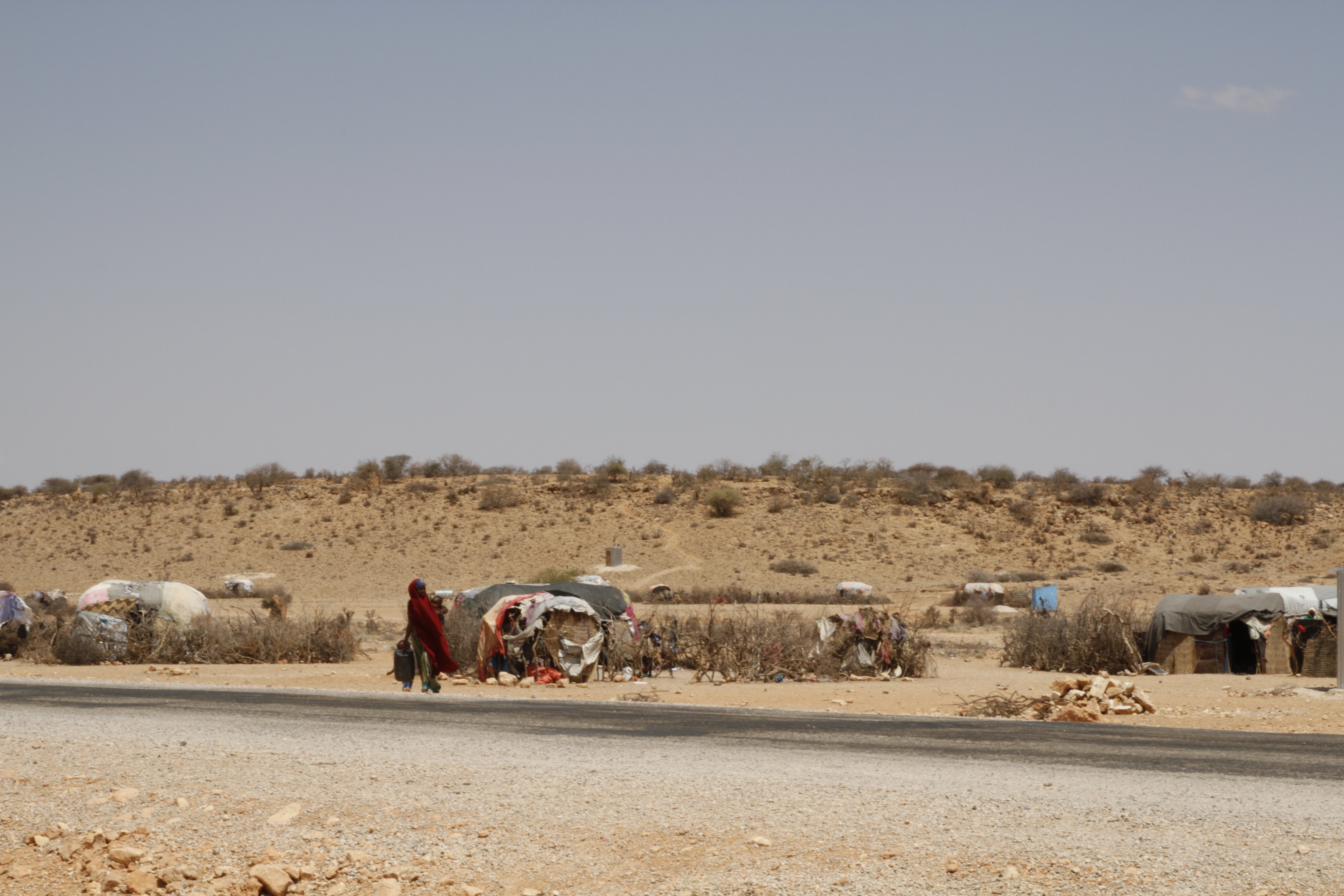In a region with one out of five drought-affected people in Somalia, Oxfam is helping people in Somaliland survive the loss of livestock, and find new ways to make a living.
Well off the main road, down a dirt track and across an arid and windswept plain lies Dur Dur camp, a place where people come to seek water, shelter, and safety. After four years of drought in Somaliland, a region along the northeast coast of the Horn of Africa, the families in Dur Dur have lost their livestock, for many of them their only means of earning money.
Among them is Safiya Aden. She’s a tall, strong woman who came here three months ago, after nearly all her 40 goats had died, and her neighbors had lost all their livestock and departed. She finally decided to leave her village because she and her eight children felt isolated and unsafe. Most unsettling for them were the hyenas prowling around their home at night, scavenging on the corpses of the dead livestock.
The 38-year-old single mother gathered her children and five remaining goats and walked for five days to Dur Dur, where she joined about 800 other families. She lives in a shelter of sticks and branches with pieces of fabric and plastic stitched together and stretched across them.

Sitting in the shade of a fence of tree branches she has constructed, Aden wears a brown hijab, which she pulls nervously around her shoulders and face. She speaks quietly about her arrival in Dur Dur, where camp residents “gave us food and materials to make a shelter.” There is water here, thanks to the efforts of Oxfam; the 5,000-liter tank sits near Aden’s shelter, and she can see women with brightly colored jerry cans wait in line, their robes whipping in the gusty wind.
Aden, like everyone else at Dur Dur, is struggling to survive. “I have no job, no income, and no food. If a neighbor brings food, we eat, maybe once a day,” she says, holding up one finger and then throwing her hand down.
Drought and famine in Somalia
Somaliland is currently enduring a sustained climate-induced drought after an unprecedented four consecutive failed rainy seasons in parts of Ethiopia, Kenya, and Somalia. In Somalia, as many as 5.6 million people are "experiencing high levels of food insecurity" and and there is an increasing risk of famine in some areas in 2023. About 20 percent of the people affected by drought in Somalia are in the northwest coast in Somaliland, according to the United Nations.

Unlike southern Somalia, some areas of western Somaliland have seen minimal rain, and there is less conflict here. This make it easier for the UN and humanitarian groups like Oxfam to deliver assistance: Oxfam is providing water and latrines in camps for displaced people across eastern Somaliland to help people survive. Oxfam’s program also distributes cash to camp residents so they can buy food and other essentials.
Crisis for people and livestock
Safiya Aden’s story is a common one in eastern Somaliland right now: Families that rely on raising camels, sheep, and goats are losing their animals and their main source of income. Many of the families in camps for displaced people like Dur Dur report losing 75 to 90 percent of their herd, forcing them to seek assistance to survive.
“I have never seen this situation before,” says one 74-year-old herder named Jama, who has seen a few dry periods over the years, including the 2011 famine that killed a quarter million people in Somalia. “People had some livestock left,” after 2011, Jama explains. But many have not recovered from the subsequent 2016-2017 drought, leaving them unable to cope with the current situation. “I have never seen a worse drought,” he says.

“Livestock cannot survive without rain and pasture,” says Mawlid Kalinleh Ismail, head of Oxfam’s humanitarian program in Somaliland. “Pastoralists are the most affected segment of the population. I think this very traditional and basic way of living is coming to an end before our eyes.”
Options for those without animals
Without livestock, what does the future hold for pastoralist families? In the community of El Migdan, in the eastern Sanaag region of Somaliland, Oxfam is helping former pastoralists to adapt and survive at a “farmer field school” where they learn to grow vegetables and fruit. To provide water, Oxfam helped to repair a well, and installed solar panels to power the pump and a system to treat and purify the water for human consumption. Nearby, another more shallow, untreated well serves livestock and irrigates a nearby fenced-in field for the training program, which has been operating for three years and teaches about 25 farmers at a time for three months.
“The first thing we teach them is how to grow tomatoes and onions,” says Hussein Ibrahim, 35, who coordinates Oxfam’s work on livelihoods in the Sanaag region. “It’s a big change to shift from livestock to agriculture,” he says.
Abdoulahi Hashi, 35, a married father of seven children who lost 100 animals in the 2017 drought, is making the transition. “After we lost our livestock, we needed to find another way to make a living, so that’s farming,” Hashi explains, as if the logic of the decision stands for itself. He has an air of confidence about him, and after speaking with him for just a few minutes, you can understand why: After three years as a farmer, Hashi is reporting some success. He recently sold a literal truckload of watermelons for $3,000 – an amount nearly twice the average income per capita in Somaliland.
Preparing for the worst
In the El Afweyn district in eastern Sanaag, a few kilometers east of El Migdan, Oxfam helped the residents of Khalsheekh repair a well, install a solar-powered pump, and pipe the water several kilometers to the town and into an elevated tank also supplied by Oxfam that serves 100 households.
“All the water we use comes from here,” says Khalsheekh’s Mayor Mohamed Hussein, a powerful-looking man with a shaved head, shielding his eyes from the late-afternoon sun with his hand on his forehead. “Oxfam also trains farmers and supports greenhouse construction, and has provided cash to displaced people two or three times.”
Another pipe supplies the nearby farmer field school where former-pastoralist farmers grow cabbages, onions, chilis, beets, and tomatoes. One 40 -meter by-10-meter greenhouse is full of tomato plants. Nearby is a nursery of small papaya trees. Fifty farmers work here, accepting digital payment from wholesale and individual customers.
Hussein also leads his town’s efforts to reduce their vulnerability to disasters such as drought and famine. At a meeting in Khalsheekh, just outside a community building on the side of the road, a group of volunteers describe how they use mobile phones to track 11 data categories such as livestock health, rainfall, and locust activity and report them to the Somaliland Disaster Agency. The government agency trained the volunteers to “forecast disasters like drought and locusts, how to make contingency plans, and share them before there is a problem,” says Hassan Mohammed, 35, a married father of eight children in Khalsheekh.

He speaks enthusiastically, explaining that the data feeds into an early warning system and helps them know when they need to trigger early actions to avoid a disaster. Right now, a worried-looking Mohammed says, “They told us to save food, animal feed, and seeds.”
This is the first effort by the village to manage risks and reduce their collective vulnerability to drought and famine and loss of livestock. They established a contingency fund, with contributions from the community, that sets aside money for difficult times. Members of the Somali diaspora in the US and other countries can contribute to the fund. It’s all online and accessible, Mohammed explains.
Oxfam program manager Mawlid Ismail finds this initiative particularly inspiring. “It’s owned by the community, not something Oxfam is designing and doing,” he says. “It is something the people are doing, but we are there to support financially and technically.”
Khalsheekh’s Mayor Hussein says he welcomes the collaboration. “We have a lot of needs, and God won’t meet all of them, so we need Oxfam to work with us.”
